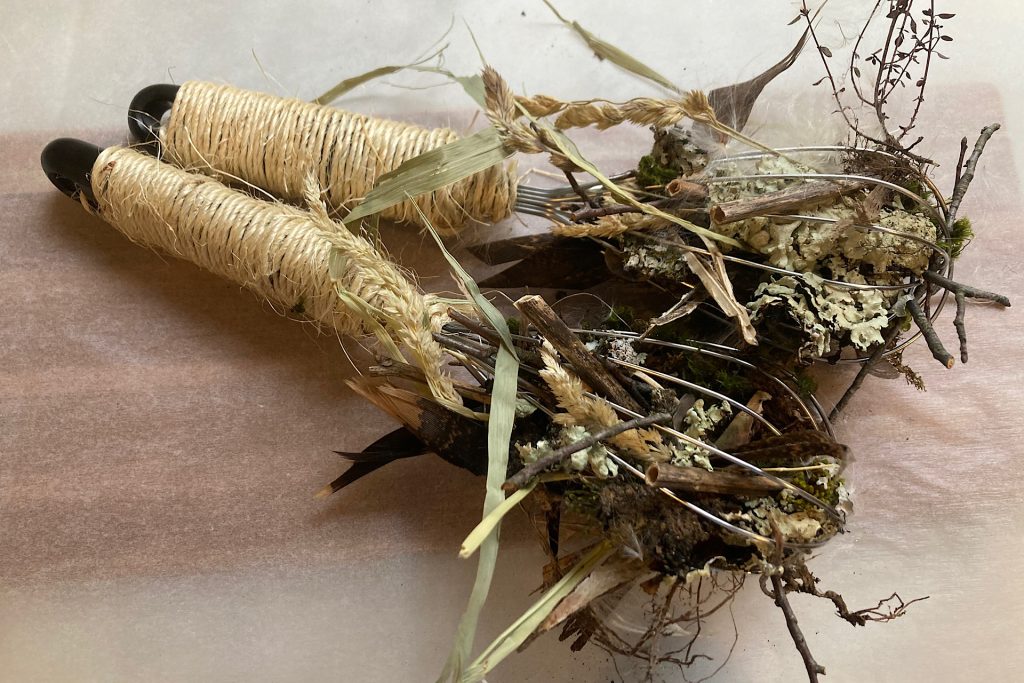Spring is in the air and backyard birds are busy gathering nesting materials. This week, we’ll craft a bit of sweet outdoor whimsy that will offer up a variety of safe building supplies for our feathered friends. But, before we are whisked away, I would like to extend heart-felt thanks to artist, Jen Wyzykowski, for providing the lovely illustration for this week’s post. She captured my idea beautifully – If you enjoy her work as much as I do, feel free to visit her at: https://jenwyz.com/ or follow her on Instagram @jenwyz_art.
An Idea “Springs” up!

Nesting Materials You Can Provide Backyard Birds
Safe Nesting Materials Birds Naturally Select
- twigs (under 4″)
- leaves
- stems
- fluffy down (milkweed)
- moss
- mud
- dried grass
- straw
- natural fibers (wool, cotton, hemp, sisal)
- shed snake skin
- animal fur
- feathers
- lichen
- rootlets



Materials You Should Avoid
- yarn or string (can entangle birds and their young)
- human hair
- horse mane and tail hair
- dryer lint (soaks up water, is steeped in chemicals, crumbles in the nest and leaves holes)
- synthetics and plastics

Making A Whisk Cage for Nesting Materials
If you have an old whisk in the kitchen that you would like to replace, this is a good repurpose option for it. I found the two I used for this project on a sale table at the grocery store. The total came in under five dollars.
Wrapping the Handle
I chose to wrap the handles with twine for a more rustic look and to provide birds with a surface they could grasp while pulling nesting materials from the whisk’s cage. Simply thread the twine through the hole in the handle, wrap to the bottom of the handle and tie it off.



Gathering Materials
Now for the fun part, foraging! I gathered all the nesting materials I used from my backyard and surrounding wood line. I was able collect a nice assortment of materials from the recommended list above. Aside from the horsehair I saved from my grooming session, I gathered moss, lichen, dried grass, twigs and stems. I was also able to salvage a milkweed pod and turkey feather from a floral arrangement I had put together last fall and set aside.


Filling the Whisk Cage
You’ll be surprised how much you can fit in a whisk cage. I used everything I gathered without a problem. You cannot do this wrong; enjoy the process and shape your whisk however you’d like. You can let some items, like rootlets, trail out the bottom or pieces of dried grass wrap around the top. Just have fun and be creative!


Hang Outdoors
I chose to add twine loops at the top of each whisk so they could hang from iron hooks outdoors. Seasonally, I use iron shepherd’s hooks for supporting hanging plants or bird feeders. Nesting materials are a good use for them now as it is too cool to set out hanging plants and bird feeders will attract black bear coming out of hibernation. Having the whisks on hooks outdoors still attracts birds for viewing, but they can easily be brought in when it rains. Bringing whisks in during inclement weather keeps the nesting materials from packing down and becoming soggy.


I hope you enjoyed this sweet, little craft project that benefits backyard birds during nesting season. It is an easy-to-do activity with children and grandchildren; providing an opportunity to learn about local wildlife, forage for materials and make something that gives back.
Resources
You may also be interested in these links:


